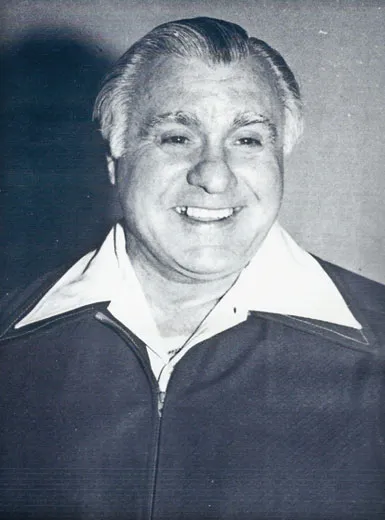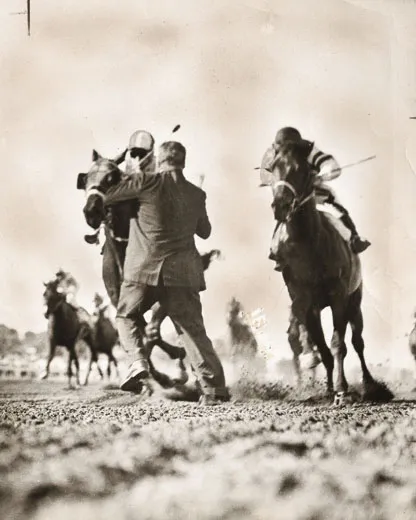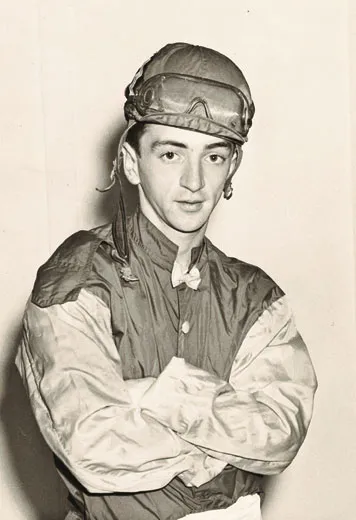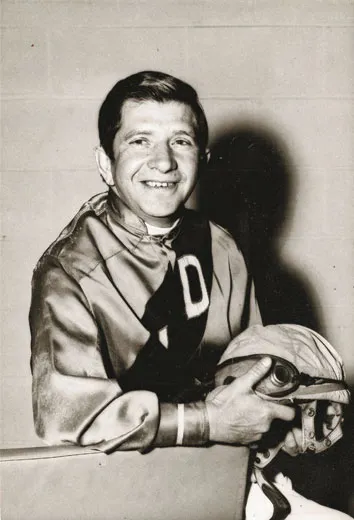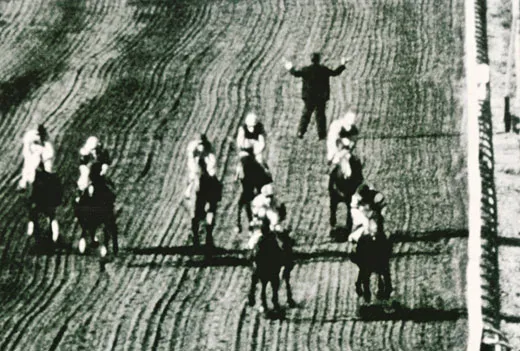At Suffolk Downs, an Unintended Spectator
Photographer Henry Carfagna was in the perfect position to catch the moment when a horse race took a bizarre turn
On July 4, 1966, more than 24,000 horse-racing fans crowded into the stands at Suffolk Downs in East Boston. The 32nd running of the Mayflower Stakes, New England’s premier race for 2-year-olds, was one of 11 races on the card that day. The press box was packed, which didn’t stop an uncredentialed punter from wandering in after the seventh race and asking where he could find the track announcer. Sam McCracken, the Boston Globe’s turf writer, directed him to the upper level of the stands. Nobody gave it much thought when the man went down to the track instead and sat on a bench about 30 feet past the finish line.
The horses that would run in the six-furlong Mayflower Stakes were soon loaded into the starting gate. I was covering the race as a 22-year-old assistant to the Boston Traveler’s turf writer, Gerry Sullivan. The race quickly turned into a head-to-head battle between two of the favorites, Happy Voter, ridden by Frank Iannelli, and Taunton, ridden by Joe Spinale. The horses were even as they entered the stretch, and the crowd rose as the two jockeys started whipping their mounts.
Henry Carfagna, the track photographer, stood atop a stand at the finish line, preparing to take his standard picture of the horses driving toward the wire. But then he saw something he’d never seen before: a man sitting on the trackside bench had leapt up and run onto the track, brandishing a rolled-up newspaper as the onrushing horses bore down on him. “I was horrified, flabbergasted,” the photographer would tell me later. “He just looked at me and kept on repeating, ‘I’m happy, I’m lucky.’...He was determined to stay there.”
In addition to the camera in his hands, Carfagna had deployed a remote-controlled unit beneath the rail past the finish line; it had but one shot. “I knew I was squeezing the button too soon,” the photographer told me, “but I wanted to make sure I got this guy in the photo.” He did, and the resulting photograph was quickly on its way to being published worldwide.
The horses neared the wire with Happy Voter and Taunton still neck and neck. As he drove Happy Voter, jockey Iannelli looked up and spotted the intruder. “I jerked my horse hard to the outside to try to avoid hitting him, but we still brushed him,” Iannelli said later. “As he spun around he tried to hit me with his fist, but he missed.”
Jockey Spinale said he and his mount, Taunton, saw the man at about the same moment. “My horse started to shy away, and I pulled him to the inside,” he said. The man “brushed the outside horse, spun around and just brushed my horse.”
Four more horses crossed the line without hitting the trespasser, but the last finisher, Misak’s Gal, spun the man around as he threw his paper into the face of jockey Tommy Sisum. “I was actually sick and wanted to heave as I was pulling my horse up,” Sisum said. “I thought I’d killed him.”
In fact, the man was unharmed. He offered no resistance as track security officers led him to the track’s administration building, where the Globe’s McCracken and I listened as the police identified him as Theodore Lupino, a 38-year-old resident of Boston’s North End who had a history of mental illness. “Now they’ll read about me tomorrow,” Lupino told McCracken. “Nobody knew who I was, but now they will know me and recognize me.” In the moment, the police weren’t sure whether to charge Lupino or take him for psychiatric observation. (And no record reflecting their decision survives.)
In the meantime, the track stewards watched films of the race and decided to make the result official: Happy Voter won, and Taunton finished second. Taunton’s trainer, Vinnie Blengs, asked Spinale why he’d pulled up the horse. “I told him about the man on the track,” the jockey said, “and Vinnie, whose view was blocked by the big crowd near the rail, said, ‘Boy, I’ve heard a lot of excuses in my day, but never one like that.’”
The picture was splashed all over the next day’s local newspapers, and it was distributed nationally and internationally over wire services. Then Life magazine published it, for a fee of $250 or $350—Carfagna couldn’t remember which when he recalled the story a decade later. Life “also acted as my worldwide agent,” he said, “but everyone just took it off the wire services, and I never made any more money from it.” He called it “the photograph that will never die,” brought a print to the press box and hung another in his office over what he said was a popular racetrack saying: “Where you can expect the unexpected.”
Carfagna spent more than 30 years as the Suffolk Downs photographer; he died in 2003 at age 84. The Mayflower Stakes hasn’t been run since 1988, a casualty of the general decline in racing attendance. But in 1967, a Suffolk Downs official recalled, he received a call from someone identifying himself as Ted Lupino. The caller said he’d like to make the trophy presentation at that year’s Mayflower Stakes.
Robert Temple covered Thoroughbred, harness and dog racing for the Boston Traveler and Herald Traveler in the 1960s and ’70s.
